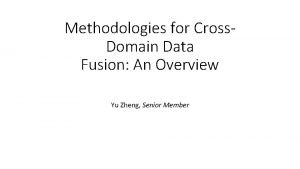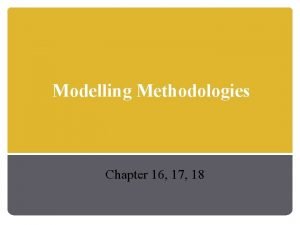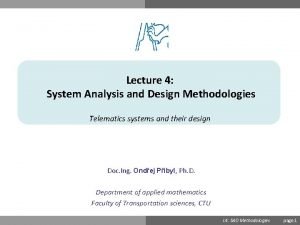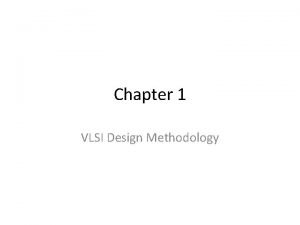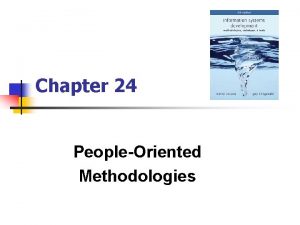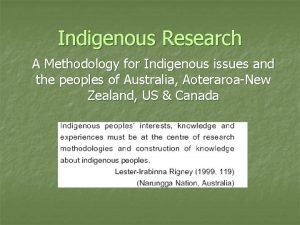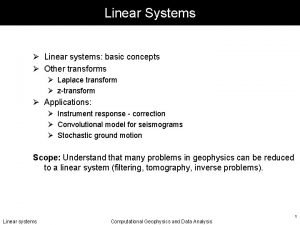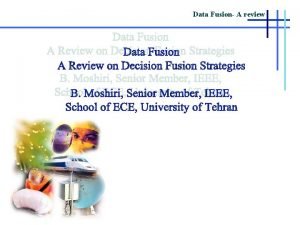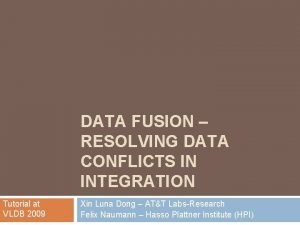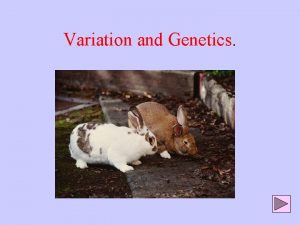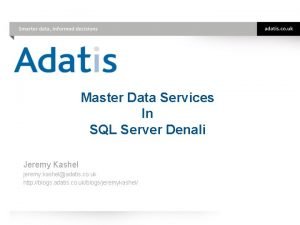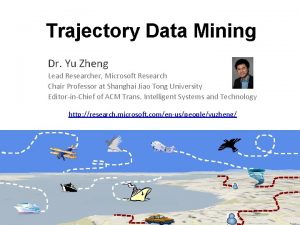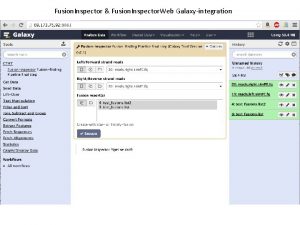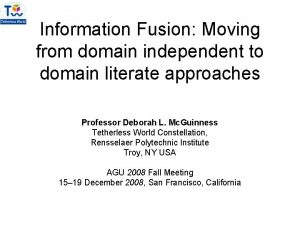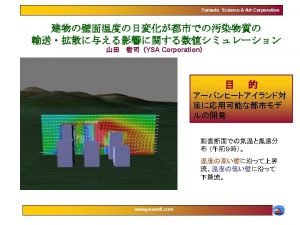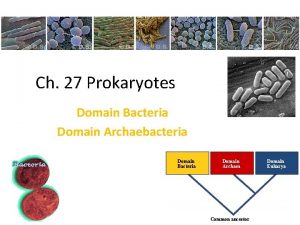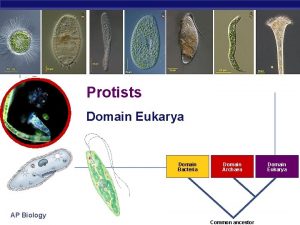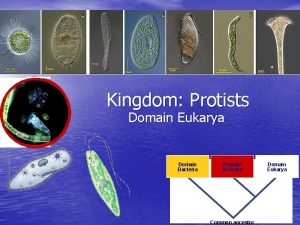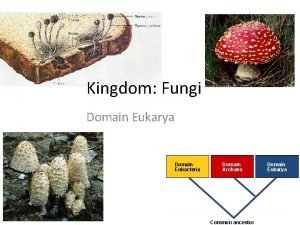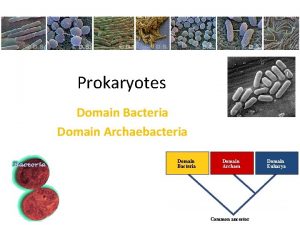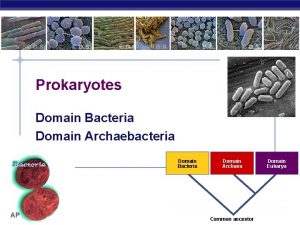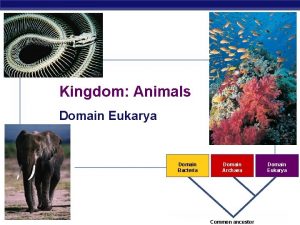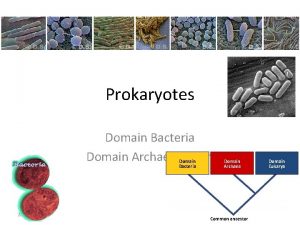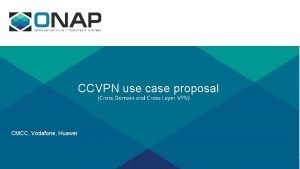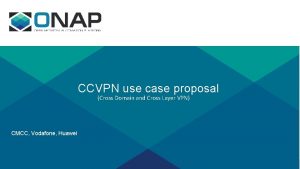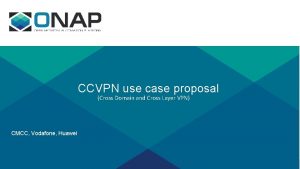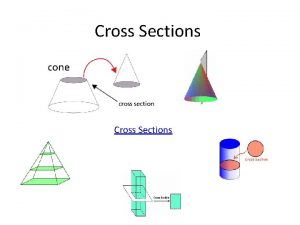Methodologies for Cross Domain Data Fusion An Overview





















































- Slides: 53

Methodologies for Cross. Domain Data Fusion: An Overview Yu Zheng, Senior Member

Abstract • How to unlock the power of knowledge from multiple disparate (but potentially connected) datasets is paramount ( 重要的)in big data research, essentially distinguishing big data from traditional data mining tasks. • Summarizes the data fusion methodologies, classifying them into three categories: 1. Stage-based 2. Feature level-based 3. Semantic meaning-based data fusion methods

1. 1 Introduction • When addressing a problem, we usually need to harness(治理) multiple disparate datasets. For example, to improve urban planning : 1. the structure of a road network 2. traffic volume 3. points of interests (POIs) and populations in a city. • However, the data from different domains consists of multiple modalities, each of which has a different representation, distribution, scale and density. 1. Image: pixel 2. POIs : spatial points 3. Air quality : a geo-tagged time series

1. 2 Methods • Stage-based fusion methods : Use different datasets at different stages of a data mining task. • Feature level-based methods: Learns a new representation of the original features extracted from different datasets by using deep neural networks (DNN). The new feature representation will then be fed into a model for classification or prediction. • The third category blends data based on their semantic meanings, which can be further classified into four groups.

Semantic meaning-based data fusion methods • Multi-view(多视点) learning-based : This group of methods treats different datasets as different views on an object or an event. Different features are fed into different models. The results are later merged together or mutually reinforce each other. • Similarity-based : This group of methods leverages the underlying correlation (or similarity) between different objects to fuse different datasets. • Probabilistic dependency-based : This group models the probabilistic causality (or dependency) between different datasets using a graphic representation • Transfer learning-based methods : This group of methods transfers the knowledge from a source domain to another target domain, dealing with the data sparsity problems in the target domain.

2. 1 Relation to Traditional Data Integration

2. 2 Relation to Heterogeneous Information Network • A heterogeneous(不同成分的) information network consists of nodes and relations of different types. For example, a bibliographic information network consists of authors, conferences and papers as different types of nodes. • Heterogeneous information networks can be constructed in almost any domain, such as social networks, ecommerce, and online movie databases. However, it only links the object in a single domain rather than data across different domains. • Consequently , algorithms proposed for mining heterogeneous information networks cannot be applied to cross-domain data fusion directly.

Stage-based Data Fusion

Road network and taxi trajectories • partition a city into regions • map the GPS trajectories of taxicabs onto the regions to formulate a region graph • each node is a region • edge denotes aggregation of commutes between two regions

Users’ trajectories and POIs

GPS trajectories and Social Media • first detect a traffic anomaly based on GPS trajectories of vehicles and road network data • retrieve the relevant social media that people have posted at the locations when the anomaly was happening

Feature base Data Fusion









Methodologies for Cross-Domain Data Fusion: An Overview SEMANTIC MEANING-BASED DATA FUSION Xintong Wang @ South China University of Technology Nov. 25, 2016

Semantic Meaning-Based Data Fusion l Feature-based data fusion method: Regard a feature solely as a real-valued number or a categorical value. l Semantic meaning-based methods: Understand the insight of each dataset and relations between features across different datasets. ü Interpretable and meaningful. Xintong Wang @ South China University of Technology Nov. 25, 2016

Outlines: l Multi-View Based Data Fusion 1. Co-Training 2. Multi-Kernel Learning 3. Subspace Learning l Similarity-Based Data Fusion l Probabilistic Dependency-Based Fusion l Transfer Learning-Based Data Fusion Xintong Wang @ South China University of Technology Nov. 25, 2016

Multi-View Based Data Fusion: l Identify a person: Face, Fingerprint, Signature… l Image Representation: Color, Texture features… ü Latent consensus, Complementary… ü Describe an object comprehensively and accurately. Xintong Wang @ South China University of Technology Nov. 25, 2016

Outlines: l Multi-View Based Data Fusion 1. Co-Training 2. Multi-Kernel Learning 3. Subspace Learning l Similarity-Based Data Fusion l Probabilistic Dependency-Based Fusion l Transfer Learning-Based Data Fusion Xintong Wang @ South China University of Technology Nov. 25, 2016

Co-Training: l Co-Training method partitions each example into TWO distinct view making THREE assumptions: Ø Sufficiency, Compatibility, Conditional independence Xintong Wang @ South China University of Technology Nov. 25, 2016

Co-Training: Example: Infer the fine-grained air quality throughout a city based on five datasets: Ø Air quality, Meteorological data, Traffic, POIs, Road Network. Ø Temporal dependency and spatial correlation formulate two distinct views. Xintong Wang @ South China University of Technology Nov. 25, 2016

Co-Training: Example: Infer the fine-grained air quality (Cont. ) Ø Spatial Classifier: ANN (spatial-related features) Ø Temporal Classifier: CRF (temporal-related features) Ø Infer an instance: Maximizes the production of the results from the two classifiers. Xintong Wang @ South China University of Technology Nov. 25, 2016

Outlines: l Multi-View Based Data Fusion 1. Co-Training 2. Multi-Kernel Learning 3. Subspace Learning l Similarity-Based Data Fusion l Probabilistic Dependency-Based Fusion l Transfer Learning-Based Data Fusion Xintong Wang @ South China University of Technology Nov. 25, 2016

Multi-Kernel Learning: l Multi-Kernel Learning (MKL) refers to a set of ML methods that uses a predefined set of kernels and learns an optimal linear or non-linear combination of kernel as part of the algorithm. l Kernel, a hypothesis on the data: classifier, regression… Xintong Wang @ South China University of Technology Nov. 25, 2016

Multi-Kernel Learning: l Multi-Kernel Learning (Conts) : Two uses of MKL Ø A learning method picks the best kernel, or uses a combination of these kernels. i. e. linear, polynomial and Gaussian kernel used in SVM. Ø Train different kernel using inputs coming from different representations: Combining kernels: intermediate combination (NOT early or late) Xintong Wang @ South China University of Technology Nov. 25, 2016

Multi-Kernel Learning: Example: Forecast the air quality for the next 48 hours of a location Ø Two kernels: Spatial Predictor and Temporal Predictor Ø A kernel learning module: Prediction Aggregator MKL-based framework outperforms a single kernelbased model: ü From the feature space’s perspective: ü From the model’s perspective: ü From the parameter learning’s perspective: Xintong Wang @ South China University of Technology Nov. 25, 2016

Outlines: l Multi-View Based Data Fusion 1. Co-Training 2. Multi-Kernel Learning 3. Subspace Learning l Similarity-Based Data Fusion l Probabilistic Dependency-Based Fusion l Transfer Learning-Based Data Fusion Xintong Wang @ South China University of Technology Nov. 25, 2016

Subspace Learning: l Subspace Learning-based method aim to obtain a latent subspace shared by multiple views: Ø Input views are generated from this latent subspace. Ø With the subspace, we can perform tasks: classification, clustering… Ø Dimensional Reduction. Xintong Wang @ South China University of Technology Nov. 25, 2016

Subspace Learning: l Subspace Learning-based method: From PCA to CCA Ø PCA is widely used to exploit the subspace for single-view data. Ø CCA is a multi-view version of PCA: Subspace is linear. Ø KCCA, Fisher discriminant analysis, Lawrence process, Statistical framework… Xintong Wang @ South China University of Technology Nov. 25, 2016

Similarity base Data Fusion


Coupled Matrix Factorization • 协同过滤 • 矩阵分解 X= U · V • X:sparse • U V: dense • 寻找中间模态数据使得X能够分解成U和V • 中间模态数据可以是另一种模态的数据,比如X是Location -> Activity, U是location -> POI, V是POI -> Activity • Video -> Wifi -> People





5. SEMANTIC MEANING-BASED DATA FUSION 5. 3 Probabilistic Dependency-Based Fusion 5. 4. Transfer Learning-Based Data Fusion

5. 3 Probabilistic Dependency-Based Fusion • Bridge the gap between datasets by probabilistic dependency • Emphasize interaction • Variables(features extracted from different datasets) --->nodes • Probabilistic dependency(between variables) ---->edge Graphical model contain hidden variables to be inferred

5. 3 Probabilistic Dependency-Based Fusion example 13 TVI(traffic volume inference

5. 3 Probabilistic Dependency-Based Fusion example 13 TVI(traffic volume inference • Traffic volume on each road lane Na influenced by 1. weather w, 2. time of day t, 3. type of road Θ, 4. the volume of observed sample vehicles Nt

5. 3 Probabilistic Dependency-Based Fusion example 13 TVI(traffic volume inference • Road’s Θ is determined by 1. road network features fr, 2. global position feature fg, 3. surrounding POIs α(influenced by fp and number of POIs) • Expectation and Maximization algorithms to learn parameters in unsupervised manner

5. 4 Transfer Learning-Based Data Fusion • Transfer between the same type of datasets • Transfer learning among multiple datasets

5. 4. 1 Transfer between the same type of datasets

5. 4. 1 Transfer between the same type of datasets • Task 1 infer an individual’s interests in different travel packages in terms o f her location history • Task 2 estimate user’s interests in different book styles based on the books has browsed • MTL framework , share representation of a user’s general interests

5. 4. 1 Transfer between the same type of datasets • Task co-predict the air quality and traffic condition at near future simultaneously • MTL framework , share representation of two datasets

5. 4. 2 Transfer learning among multiple datasets

6. DISCUSSION 1. Meta :Indicates if a method can incorporate other approaches as a method. 2. Vol :amount of Training Data. 3. Pos : Whethere are some object instances that can constantly generate labeled data. 4. Goal: Filling Missing Values (of a sparse dataset) Predict Future Causality Inference Object Profiling(性能分析) Anomaly(异常) Detection 5. Train: Supervised (S), unsupervised (U) and semi supervised (SS) learning. 6. Scale(扩展): It is not easy for probabilistic dependency -based approaches to scale up (N). With respect to the similarity-based data fusion methods, when a matrix becomes very large, which can be operated in parallel , can be employed to expedite decomposition (Y)
 Methodologies for cross-domain data fusion: an overview
Methodologies for cross-domain data fusion: an overview Domain test means
Domain test means Data modelling methodologies
Data modelling methodologies Types of empirical research
Types of empirical research System analysis and design methodologies
System analysis and design methodologies Regularity in vlsi
Regularity in vlsi Agile methodologies wiki
Agile methodologies wiki Task model
Task model Indigenous methodologies
Indigenous methodologies Business performance management methodologies
Business performance management methodologies Data quality and data cleaning an overview
Data quality and data cleaning an overview Data quality and data cleaning an overview
Data quality and data cleaning an overview Data quality and data cleaning an overview
Data quality and data cleaning an overview Levelous
Levelous Domain co domain and range of a relation
Domain co domain and range of a relation Z domain to frequency domain
Z domain to frequency domain Data domain fundamentals
Data domain fundamentals Z transform
Z transform Z domain
Z domain Domain specific vs domain general
Domain specific vs domain general Domain specific vs domain general
Domain specific vs domain general Problem domain vs knowledge domain
Problem domain vs knowledge domain S domain to z domain
S domain to z domain Specification gap is gap between
Specification gap is gap between Data fusion
Data fusion Data fusion tutorial
Data fusion tutorial Test cross and back cross
Test cross and back cross Test cross and back cross with example
Test cross and back cross with example Incomplete trait
Incomplete trait Difference between monohybrid and dihybrid cross
Difference between monohybrid and dihybrid cross In the cross, in the cross be my glory ever
In the cross, in the cross be my glory ever Steep incisal guidance
Steep incisal guidance Master data services overview
Master data services overview Sql server mds
Sql server mds Chicago time
Chicago time An overview of data warehousing and olap technology
An overview of data warehousing and olap technology Trajectory data mining an overview
Trajectory data mining an overview Fspos
Fspos Typiska novell drag
Typiska novell drag Nationell inriktning för artificiell intelligens
Nationell inriktning för artificiell intelligens Returpilarna
Returpilarna Shingelfrisyren
Shingelfrisyren En lathund för arbete med kontinuitetshantering
En lathund för arbete med kontinuitetshantering Underlag för särskild löneskatt på pensionskostnader
Underlag för särskild löneskatt på pensionskostnader Personlig tidbok för yrkesförare
Personlig tidbok för yrkesförare A gastrica
A gastrica Vad är densitet
Vad är densitet Datorkunskap för nybörjare
Datorkunskap för nybörjare Tack för att ni lyssnade bild
Tack för att ni lyssnade bild Att skriva debattartikel
Att skriva debattartikel Delegerande ledarskap
Delegerande ledarskap Nyckelkompetenser för livslångt lärande
Nyckelkompetenser för livslångt lärande Påbyggnader för flakfordon
Påbyggnader för flakfordon Arkimedes princip formel
Arkimedes princip formel
